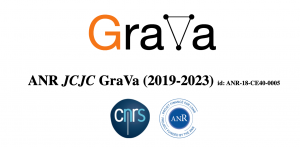CONFERENCE
Machine Learning and Signal Processing on Graphs
Apprentissage automatique et traitement du signal sur graphe
7 – 11 November 2022
Scientific Committee
Comité scientifique
Jalal Fadili (École Supérieure d’Ingénieurs de Caen)
Patrick Flandrin (CNRS, ENS Lyon)
Catherine Matias (CNRS, Sorbonne Université)
Pierre Vandergheynst (École Polytechnique Fédérale de Lausanne)
Organizing Committee
Comité d’organisation
Andreas Loukas (École Polytechnique Fédérale de Lausanne)
Nelly Pustelnik (CNRS, ENS Lyon)
Nicolas Tremblay (CNRS, GIPSA-lab Grenoble)
Samuel Vaiter (CNRS, Université Côte d’Azur)
Relational or non-euclidean data such as physical or social networks, point clouds or biological components can often be described with underlying graphs. Graphs are a key concept invarious disciplines such as computer science, social science, or medicine, as well as an incredibly rich mathematical field. It is therefore natural that they form the core of the work of an increasingly large group of researchers from machine learning, statistics, signal processing and optimization.
These communities rarely share the same venues. This conference aims to facilitate new collaborations across geographical boundaries but also to explore synergies across research topics. World-class researchers will be invited to present state-of-the-art works along with young researchers (early careers, PhD students) to promote and develop new mentorship.
The program will revolve around three major themes. First, the recent impact of Graph Neural Networks on various task of machine learning on graphs such as graph generation, representation learning, graph embedding, as well as their current limitations, and how to overcome them. Second, how statistical properties of random graphs can be exploited in learning theory, and what kind of asymptotic and non-asymptotic behaviour we can expect for static and dynamic graphs. Finally, how new optimization methods can help graph signal processing, including non-smooth and distributed methods.
Les données relationnelles, ou non-euclidiennes, comme les réseaux physiques ou sociaux, les nuages de points sont souvent décrits à l’aide d’un graphe sous-jacent. Les graphes sont un concept clé dans des disciplines diverses, comme l’informatique, les sciences sociales ou la médecine, tout comme il s’agit d’un domaine incroyablement riche des mathématiques. Il est donc naturel que ces objets soient au coeur du travail d’un groupe de plus en plus large de chercheurs de l’apprentissage automatique au traitement du signal, en passant par les statistiques et l’optimisation.
Ces communautés partagent rarement les mêmes évènements. Cette conférence a pour but de faciliter de nouvelles collaborations internationales ainsi que d’explorer des synergies à travers plusieurs thèmes de recherche. Des chercheurs de renommées internationales seront invités à présenter leur derniers résultats ainsi que des chercheurs en début en carrière et des doctorants pour promouvoir et développer de nouvelles interactions.
Le programme sera orienté vers trois thèmes majeurs. Le premier est l’impact récent des réseaux de neurones sur graphes sur de multiples tâches en apprentissage tel que la génération, la représentation, les plongements de graphes, ainsi que leurs limitations actuelles et comment les surmonter. Ensuite, un autre focus sera dédié aux propriétés statistiques des graphes aléatoires, et comment les exploiter en apprentissage, notamment quels comportements asymptotiques et non-asymptotiques peut-on attendre pour des graphes statiques, et également dynamiques. Enfin, le dernier axe sera consacré aux méthodes d’optimisation et leur impact sur le traitement du signal sur graphe, incluant les méthodes non-lisses et distribuées.
SPEAKERS
Sophie Achard (CNRS, Université Grenoble Alpes) Statistical comparisons of spatio-temporal networks
Sergio Barbarossa (Sapienza University of Rome) Topological Signal Processing and Learning
Simon Barthelme (CNRS Gipsa-Lab Grenoble) Graph Sampling using Determinantal Point Processes
Robert Beinert (TU Berlin) Linear Gromov-Wasserstein distances
Pierre Borgnat (ENS Lyon) Metric Learning for attributed graphs
Fabienne Castell (Aix-Marseille Université) Spectral estimation through Kirchoff’s random forests
Nicolas Courty (Université Bretagne Sud) Optimal transport for graph-signal processing
Yohann De Castro (École Centrale de Lyon) Markov Random Geometric Graph (MRGG): A Growth Model for Temporal Dynamic Networks
Xiaowen Dong (University of Oxford) On the stability of spectral graph filters and beyond
Kimon Fountoulakis (University of Waterloo) Graph Attention Retrospective
Elvin Isufi (Delft University of Technology) Graph Neural Networks over Random Graphs
Ulrike von Luxburg (University of Tübingen) Clustering with Tangles
Haggai Maron (NVIDIA Research) Subgraph-based networks for expressive, efficient, and domain-independent graph learning
Antonio Ortega (University of Southern Carolina) Graph Constructions for Machine Learning Applications: New Insights and Algorithms
David Shuman (Franklin W. Olin College of Engineering) Signal Processing on the Permutahedron: Tight Spectral Frames for Ranked Data Analysis
Dorina Thanou (EPFL) The inductive bias of message passing neural networks
Dimitri Van de Ville (École Polytechnique Fédérale de Lausanne) Graph Signal Processing to Quantify Brain Structure-Function Coupling
Titouan Vayer (INRIA – ENS Lyon) Towards Compressive Recovery of Sparse Precision Matrices
Nicolas Verzelen (INRAE Montpellier) Localization in 1D non-parametric latent space models from pairwise affinities
Clément Vignac (EPFL) DiGress: Discrete Denoising diffusion for graph generation
Lenka Zdeborová (École Polytechnique Fédérale de Lausanne)



